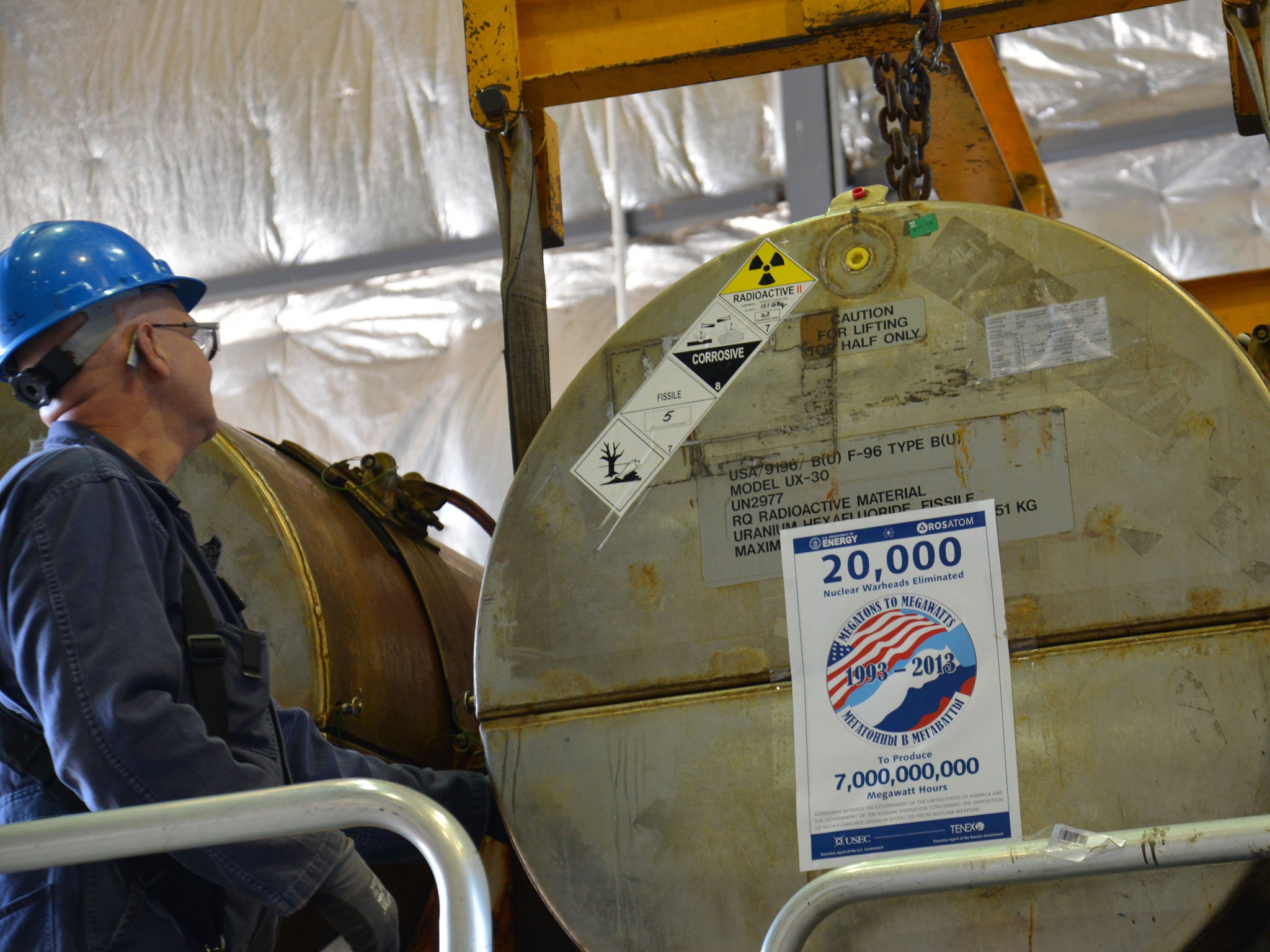How America uses Russian warheads to heat its homes
For 10 years shipments of uranium have been quietly changing hands

Your support helps us to tell the story
From reproductive rights to climate change to Big Tech, The Independent is on the ground when the story is developing. Whether it's investigating the financials of Elon Musk's pro-Trump PAC or producing our latest documentary, 'The A Word', which shines a light on the American women fighting for reproductive rights, we know how important it is to parse out the facts from the messaging.
At such a critical moment in US history, we need reporters on the ground. Your donation allows us to keep sending journalists to speak to both sides of the story.
The Independent is trusted by Americans across the entire political spectrum. And unlike many other quality news outlets, we choose not to lock Americans out of our reporting and analysis with paywalls. We believe quality journalism should be available to everyone, paid for by those who can afford it.
Your support makes all the difference.It is one of the most remarkable but little-known examples of post-Cold War co-operation between Russia and the US.
But the “Megatons-to-Megawatts” programme – which has seen 20,000 decommissioned Russian nuclear warheads shipped to the US to generate nuclear energy for American homes – is now coming to an end, after the final consignment completed its four-week sail from St Petersburg to Baltimore.
The final 160-tonne batch of low-enriched uranium marks the end of an unprecedented 20-year programme which has seen the US pay its old enemy of a total of $8bn (£5bn) for the unconventional fuel.
Having anchored in Baltimore, that final shipment was taken to the Paducah Gaseous Diffusion Plant in Kentucky, where it will be turned into uranium oxide pellets and farmed out to nuclear power plants across the US.
Reflecting on the scheme’s success earlier this month, programme manager John Welch said: “We have fuelled the production of clean, reliable energy through an historic non-proliferation programme.”
But it so nearly didn’t happen. Towards the end of the Cold War, Philip Sewell, one-time deputy assistant secretary at the US Department of Energy, was charged with finding ways to collaborate with former adversaries. His work involved driving out into the Russian countryside, to military facilities that weren’t even on the map – and what he saw didn’t inspire him with confidence.
“Windows were broken, gates were not locked, and there were very few people around,” Mr Sewell told The Independent. But inside those crumbling buildings, the Russian government stored the uranium from thousands of decommissioned nuclear weapons – material terrorists could have used to make a bomb.
Mr Sewell and his colleagues decided the situation was so dangerous that they needed to get rid of the uranium and set about persuading the Russians to sell their surplus to the US.
Initially, he was refused. “It was a matter of pride, principle and patriotism. Even though they didn’t need that excess material and they didn’t have the money to protect it, they didn’t want to let go of it,” he says.
But in the end, they had so little money that Russia yielded and the partnership was formed. Mr Sewell is now chief development officer at USEC, the US enriched uranium producer that ran the scheme.
The process began with the removal of the warheads and their highly enriched uranium metal components which were machined into metal shavings that were then heated and converted to a highly enriched uranium oxide. This was heated to produce a gas, which was mixed with a very low enriched uranium material and diluted to less than 5 per cent concentration of the fissionable uranium-235 isotope, a level too low to be of any military value but ideal for producing electric power.
This was then transferred to 2.5-ton steel cylinders, enclosed in protective shipping containers and sent to a storage and handling facility in St Petersburg. From there it was shipped to US fuel fabricators, where it was converted into uranium oxide pellets and fabricated into fuel assemblies, which were delivered to utilities for use in their nuclear reactors.
Although Megatons-to-Megawatts has now ended, Russia will continue to supply low enriched uranium to the US. That ten-year programme, which began on a small-scale this year, is expected to supply about half the level of Megatons-to-Megawatts by 2015, with the option to hike it to the same quantity if both parties agree. The difference is that, under the new contract, the supply will come from Russia’s commercial enrichment activities rather than from warheads.
The World Nuclear Association reports that world stockpiles of weapons-grade plutonium weigh in at an estimated 260 tonnes, which could be turned into a little over one year’s world uranium production – about 53,500 tonnes.
Join our commenting forum
Join thought-provoking conversations, follow other Independent readers and see their replies
Comments